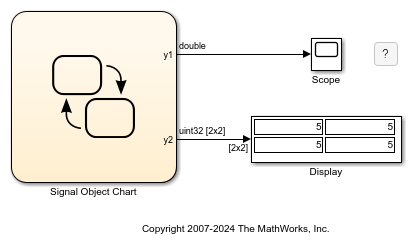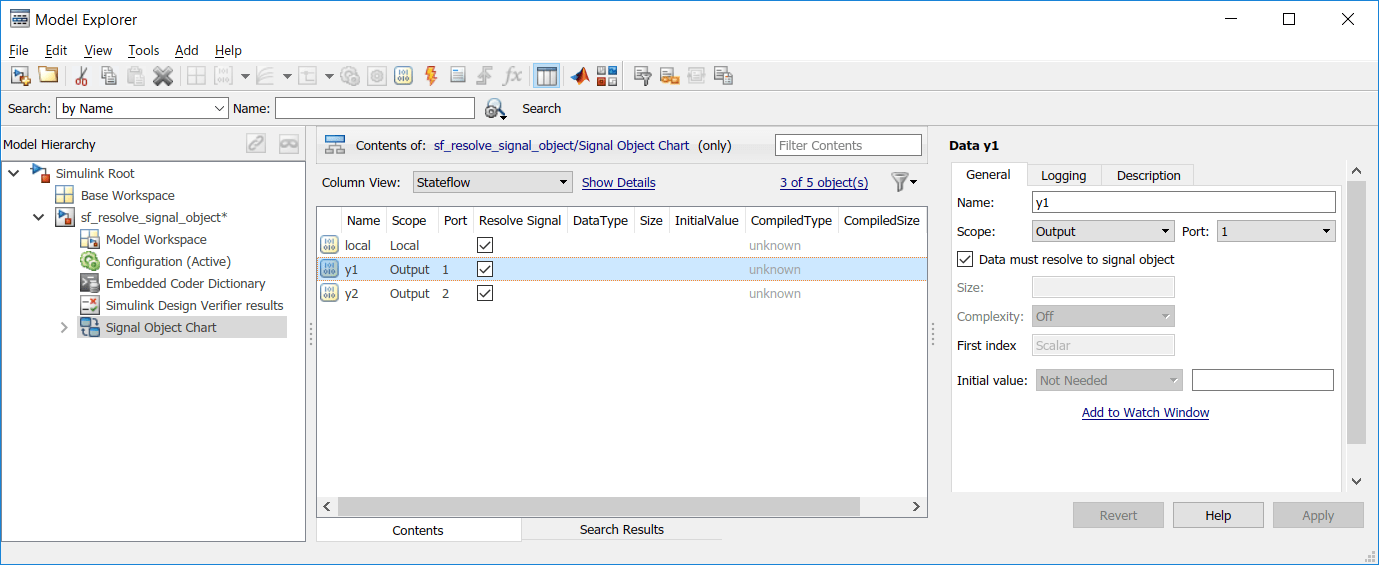Resolver propiedades de datos a partir de objetos de señales de Simulink
El ejemplo muestra cómo los datos locales y de salida de Stateflow® en gráficos pueden heredar explícitamente propiedades de objetos de Simulink.Signal en el área de trabajo del modelo o en el área de trabajo base. Este proceso se denomina resolución de señal y requiere que la señal resuelta tenga el mismo nombre que la salida del gráfico o los datos locales.
Para obtener información sobre la resolución de señal de Simulink®, consulte Symbol Resolution (Simulink) y Symbol Resolution Process (Simulink).
Propiedades heredadas
Cuando los datos locales o de salida de Stateflow se resuelven en objetos de señal de Simulink, heredan estas propiedades:
Tamaño
Complejidad
Tipo
Valor mínimo
Valor máximo
Valor inicial
Clase de almacenamiento
La clase de almacenamiento controla el aspecto de los datos del gráfico en el código generado. Consulte Organize Parameter Data into a Structure by Using Struct Storage Class (Embedded Coder).
Habilitar la resolución de señal
Para habilitar la resolución de señal explícita:
Abra el cuadro de diálogo Configuration Parameters y, en el panel Diagnostics > Data Validity, establezca Signal resolution en un valor diferente de
None. Para obtener más información sobre las otras opciones, consulte Signal resolution (Simulink).En el área de trabajo del modelo, el diccionario de datos o el área de trabajo base, defina un objeto de
Simulink.Signalcon las propiedades que desee que hereden sus datos de Stateflow. Para obtener más información sobre la creación de señales de Simulink, consulteSimulink.Signal(Simulink).Añada salida de gráfico o datos locales. Utilice el mismo nombre para sus datos que para el objeto de
Simulink.Signal.Habilite la propiedad Data must resolve to signal object, según se describe en Establecer propiedades de datos. Después de seleccionar esta propiedad, el cuadro de diálogo elimina o atenúa las propiedades que los datos heredan de la señal.
Un ejemplo sencillo
Este modelo muestra cómo un gráfico resuelve los datos de salida y locales para objetos de Simulink.Signal.

En el área de trabajo base, hay tres objetos de Simulink.Signal, cada uno con un conjunto de propiedades diferente.
y1tiene estas propiedades: Tipo =double, Dimensiones =1y Clase de almacenamiento =Model default.y2tiene estas propiedades: Tipo =uint32, Dimensiones =[2 2]y Clase de almacenamiento =Auto.localtiene estas propiedades: Tipo =single, Dimensiones =1y Clase de almacenamiento =ExportedGlobal.
El gráfico contiene tres objetos de datos (dos salidas y una variable local) que se resuelven en una señal con el mismo nombre.

Al crear el modelo, cada objeto de datos hereda las propiedades de la señal con el mismo nombre.

El código generado declara los datos en función de la clase de almacenamiento que los datos heredan de la señal de Simulink asociada. Por ejemplo, el siguiente archivo de encabezado declara que la local es una variable global exportada:
/* * Exported States * * Note: Exported states are block states with an exported global * storage class designation. Code generation will declare the memory for these * states and exports their symbols. * */ extern real32_T local; /* '<Root>/Signal Object Chart' */
Consulte también
Simulink.Signal (Simulink)
Temas
- Symbol Resolution (Simulink)
- Organize Parameter Data into a Structure by Using Struct Storage Class (Embedded Coder)